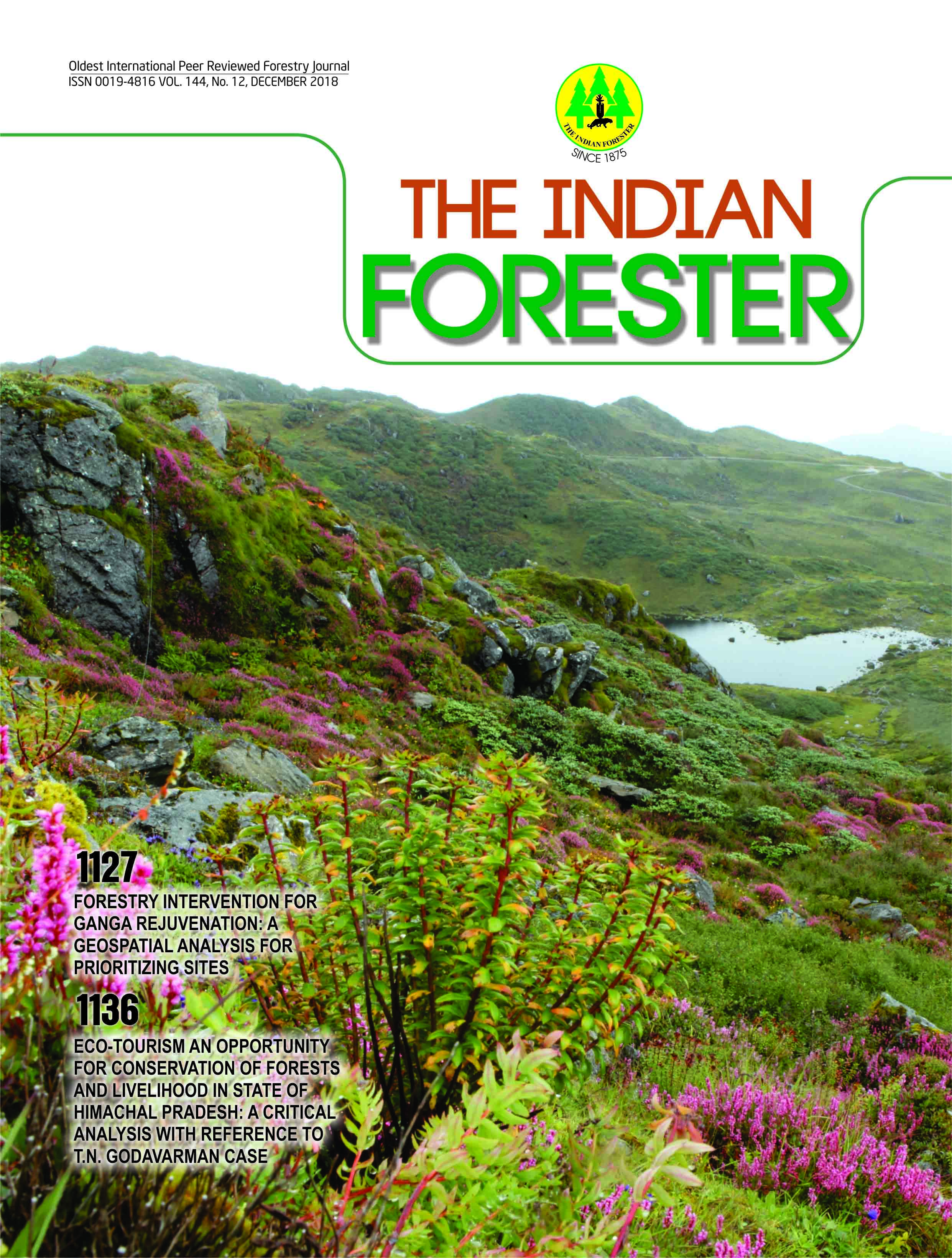Propagation of Ulmus wallichiana from Divergent Sources of North India
DOI:
https://doi.org/10.36808/if/2018/v144i12/141852Keywords:
Ulmus wallichiana, Threatened species, Branch cuttings, IBA, Germplasm.Abstract
Effectiveness of indole-3-butyric acid (IBA) has been examined in adventitious root formation in branch cuttings of Ulmus wallichiana, a threatened species. Cuttings were collected from different districts (covering states of Uttarakhand, Himachal Pradesh and Jammu and Kashmir) during the month of March. Four IBA treatments viz. 4000 ppm, 5000 ppm, 6000 ppm and 7000 ppm, in addition to control, were tested in four replications. Data on callus formation, rooting and plant per cent were recorded after twelve weeks of planting. Among all germplasm collections and IBA concentrations, the maximum rooting was 41.3 per cent recorded with 6000 ppm IBA for Mukteshwar (Nainital) and with 7000 ppm IBA for Munsyari (Pithoragarh) while the minimum rooting, excluding control, was 26.3 per cent for Bijoriya (Bageshwar) at 4000 ppm IBA. The plant percentage ranged from minimum 23.8 per cent to maximum 35.0 per cent. Without IBA, the rooting success was zero to 2.50 per cent. In view of similar rooting response of diverse germplasm, it was inferred that this species can be reliably propagated through branch cuttings with use of 6000 ppm IBA regardless of source of germplasm.References
Agarwal V.S. (2005). Directory of Indian economic plants.Bishen Singh Mahendra Pal Singh, Dehradun. 563 p.
Bhat G.M., Khan M.A. and Mughal A.H. (2007). Status, distribution and concentration of elm (Ulmus wallichiana Planchon): A multipurpose tree species in Kashmir. SKUAST J. Research, 9: 84-88.
Bhat G.M., Khan M.A. and Mughal A.H. (2008). Vegetative propagation of elm (Ulmus wallichiana planchon.) by cuttings. Ecology Environment and Conservation, 14 (1): 165-168.
Bhatt B.P. and Todaria N.P. (1991). Seasonal rooting behaviour of stem cuttings of some agroforestry species of Garhwal Himalaya. Indian J. Forestry, 13 (4):362-364.
Dirr M.A. and Heuser C.W. (1987). The reference manual of woody plant propagation: from seed to tissue culture. Athens G.A. Varsity Press. 239 pp.
FAO. (1995). Data book on endangered tree and shrub species and provenances. Paper 77. Forestry, FAO Rome.International Book Distributors, Dehradun. 506-509 pp.
Haissig B.E. (1974). Influences of auxin synergists on adventitious root primordium initiation and development. New Zealand J. Forest Science, 4: 311-323.
Hartmann H.T., Kester D.E., Davies F.T. and Geneve R.L.(1997). Plant propagation principles and practices. 6th edition, Englewood Cliffs, Prentice Hall. 770 pp.
IUCN (2010) http://en.wikipedia.org/wiki/IUCN_ Red_List_ vulnerable_species_(Plantae)
Mughal A.H. and Mugloo J.A. (2016). Elm (Ulmus wallichiana). A vulnerable lesser known multipurpose tree species of Kashmir Valley. J. Research, 18 (2): 73-79.
Nandi S.K., Palni L.M.S. and Rikhari H.C. (1996). Chemical induction of adventitious root formation in Taxus baccata cuttings. Plant Growth Regulation, 19: 117-122.
Nandi S.K., Tamta S. and Palni L.M.S. (2002). Adventitious root formation in young shoots of Cedrus deodara. Biologia Plantarum, 45 (3):473-476.
Nordstrom A.C., Jacobs F.A. and Eliasson L. (1991) Effect of exogenous indole-3-acetic acid and indole-3-butyric acid on internal levels of the respective auxins and their conjugation with aspartic acid during adventitious root formation in pea cuttings. Plant Physiology, 96: 856-861.
Singh D., Srivastava R.K. and Khanduri V.P. (2005).Marketing strategies and trade of medicinal plant in Uttaranchal, present and future prospects. Indian Forester, 131(3): 330-340.
Smith D.R. and Thorpe T.A. (1975). Root initiation in cuttings of Pinus radiata seedlings growth regulator interactions. J.Experimental Botany, 26:193-202.
Stefancic M., Stampar F. and Osterc G. (2015). Influence of IAA and IBA on root development and quality of Prunus 'GiSelA 5' leafy cuttings. Hort. Science, 40(7): 2052-2055.
Struve D.K. and Moser B.C. (1984). Auxin effects on root regeneration of Scarlet Oak seedlings. J. American Horticulture Science, 109 (1):91-95.
Tamta S., Palni L.M.S. and Nandi S. K. (2007). Adventitious root formation in shoot cuttings of Himalayan Cedar (Cedrus deodara Roxb. Ex. Lamb) G. Don under mist chamber conditions. J. Non-Timber Forest Products, 14 (3):231-238.
Yang T. and Davies P.J. (1999). Promotion of stem elongation by indole-3-butyric acid in intact plants of Pisum sativum.Plant Growth Regulation, 27: 157-160.
Downloads
Downloads
Published
How to Cite
Issue
Section
License
Unless otherwise stated, copyright or similar rights in all materials presented on the site, including graphical images, are owned by Indian Forester.





